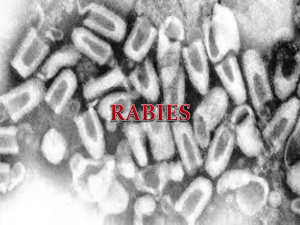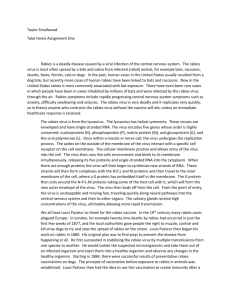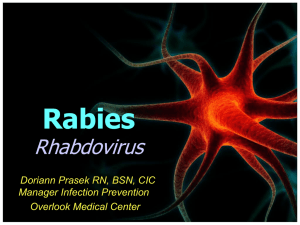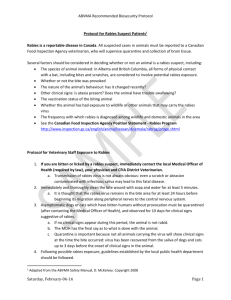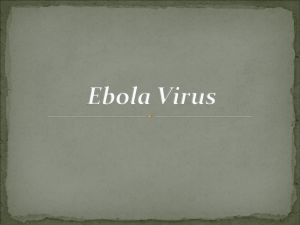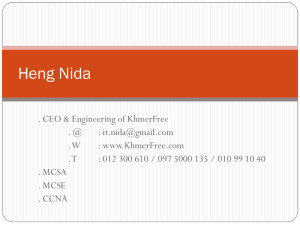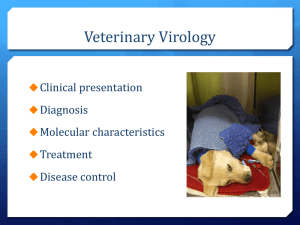each month
advertisement
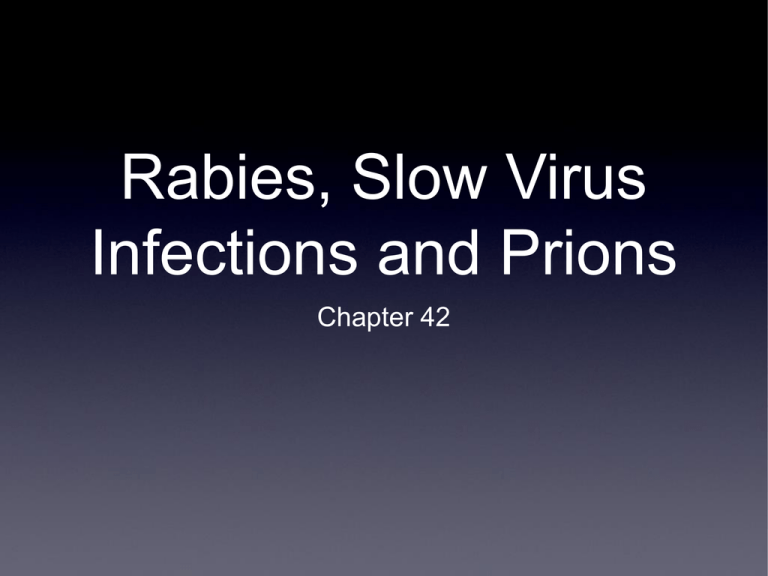
Rabies, Slow Virus Infections and Prions Chapter 42 Rhabdoviruses • • Features Bullet-shaped (75 x 180 nm) Enveloped Single stranded RNA genome, 12 kb Many viruses with broad host ranges Classification Family Rhabdoviridae Genus Lyssavirus (including Rabies virus) • • • • • • • • • • Vertebrates Invertebrates Plants Genus Vesiculovirus (Vesicular stomatitis-like viruses) Rabies Virus • Rabies virus replication • • Spike protein mediates attachment (nicotinic acetylcholine receptor) Viral RNA polymerase transcribes a monocistronic mRNA • • • Five polypeptides are encoded by the genome N L (polymerase) P (polymerase) M G • • • • • The N assembles with the polymerase and RNA in progeny virus (spiral configuration) Virus exits by budding • • G protrudes from plasma membrane M binds to inner PM leaflet Rabies Virus • Animal susceptibility All warm-blooded animals can be infected with varying susceptibility High - wolves, coyotes, foxes, dogs Intermediate - skunks, raccoons, bats Low - opossums Virus occurs in saliva, nervous system, urine, lymph, milk Recovery is rare and only occurs in bats; fatal in nearly all others Vampire bats can transmit virus for months • • • • • • • • Pathogenesis • • • • • • • • • Rabies Virus Requires several weeks for infection to become apparent Transmission through bite or scratch from infected animal Replication in muscle and connective tissues at site of inoculation Enters peripheral nervous system at neuromuscular junctions Spreads up the peripheral nerves to the central nervous system Encephalitis Virus grows to high titers in the salivary glands • Rabies patients must be restrained Negri bodies appear in neuron cell bodies Clinical spectrum • • • Prodrome - nausea, headaches, fever, sore throat, photophobia Acute neurologic phase - apprehension, nervousness, hallucinations, behavioral anomalies, salivation, perspiration, hydrophobia, photophobia Coma - seizures and death (99+%) Negri bodies Rabies Virus • One survival using novel medical treatment NEJM. 2005. 352:2508-2514 15 year old Jeanna Giese bitten by a bat Presented with clinical rabies after one month Treatment • • • • • • • • • • • • Induced coma Administered high doses of ketamine to suppress brain activity • Required mechanical ventilation Administered heparin Administered ribavirin, an antiviral, to protect the heart from rabies-induced cardiomyopathy Days 8-10 showed improvement in cardiovascular and neurological functions By day 23 she could sit up in bed, but neurological manifestations persisted Required prolonged physical therapy, but is continuing to recover This treatment failed for a Texas boy • • • Rabies Virus Laboratory diagnosis PCR Serology (IFA) Animal control Rabid or suspected rabid animals are killed and examined by histopathology for Negri bodies and viral antigen Vaccination of pets is required by law in most states Immunity and protection Vaccines • • • • • • • • First one developed by Pasteur by using spinal cords from infected dogs Today’s principal vaccine is the human diploid cell vaccine (HDCV) made in the WI-38 fibroblast cell line • Virus is inactivated by βPL Post-exposure prophylaxis • • One dose of hyperimmune antiserum Five immunizations over 28 days Rabies Virus • Epidemiology Enzootic in wild and domesticated animals • • • • In the U.S., edible vaccines are dispersed to control wild animal rabies More than 200 people die from rabies in China each month Reservoirs might be bats • But the slow-growing nature of rabies virus also contributes to its persistence in nature Prion Diseases • • Proteinacious infectious agents Diseases are transmissible spongiform encephalopathies (TSEs) • • • There are also inherited spongiform encephalopathies Human • • • • Creutzfeldt-Jakob Disease - sporatic New Variant CJD - from beef (“mad cow disease”) Kuru - ritualistic cannibalism (consuming brains of infected dead) Fatal familial insomnia Animal • • • Bovine spongiform encephalopathy (“mad cow” disease) Scrapie - sheep Chronic wasting disease - deer, elk, moose • Pathogenesis Poorly understood The prion protein is a normal cellular protein, encoded by the PRPC gene Prion Diseases • • • • • • • • • • The gene is found on the short arm of chromosome 20 It is thought to be involved in ion transport It is prominently expressed in the CNS Normal Misfolded Some mutant alleles occur in familial enecphalopathies Protein folding • • The properly-folded protein is termed PrPc The misfolded protein is termed PrPSc It is unknown why the protein misfolds However, once misfolded, it can cause misfolding of other copies of PrPc The misfolded protein is highly resistant to heat and protease digestion • • • TSEs have been transmitted by autoclaved surgical instruments The misfolded proteins apparently elude the ubiquitin/proteosome system Cells export the misfolded protein, which then forms extracellular plaques
